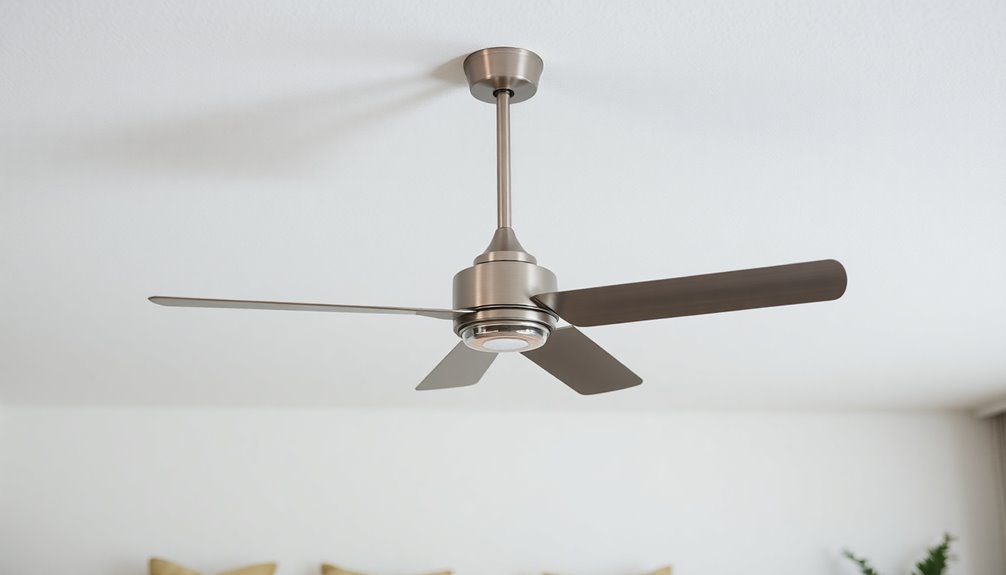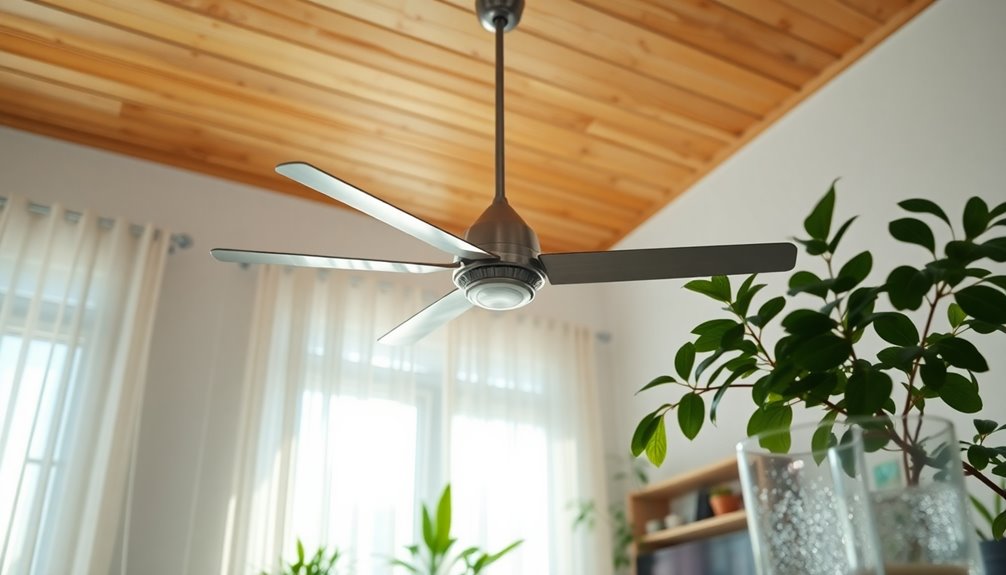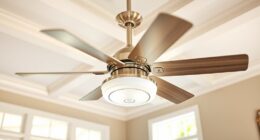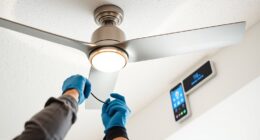A standard ceiling fan usually consumes between 50 and 100 watts per hour, with most averaging around 75 watts. This means that when you run a 75-watt fan for an hour, it'll cost you approximately $0.0075 to $0.0132. If you use it daily for about six hours, you're looking at a monthly cost of around $2.74. Factors like fan size, speed settings, and duration of use can impact overall energy consumption. For more precise strategies on how to optimize usage and save on costs, you might want to explore further.
Key Takeaways
- Standard ceiling fans consume between 50 to 100 watts per hour, averaging around 75 watts.
- Operating a 75-watt fan for one hour costs approximately $0.0075 to $0.0132.
- Energy-efficient ceiling fans can use as little as 15-25 watts, significantly reducing energy consumption.
- Larger fans (52-inch) typically consume about 90 watts per hour, while smaller fans (36-inch) use around 55 watts.
- Regular maintenance, like cleaning blades, can enhance efficiency and lower energy usage over time.
Ceiling Fan Energy Overview

When you flip the switch on your ceiling fan, you're tapping into an energy-efficient way to stay cool. A standard ceiling fan typically consumes between 50 to 100 watts per hour, with most models averaging around 75 watts. This means that running your fan for one hour costs you roughly $0.0075 to $0.0132, depending on your local electricity rate.
In terms of energy usage, a 75-watt ceiling fan uses 0.075 kilowatt-hours (kWh) when operated for one hour. This low electricity consumption makes ceiling fans a smart alternative to traditional air conditioning systems.
While air conditioners can greatly increase your energy bills, ceiling fans allow you to circulate air with much less wattage and lower overall energy costs.
However, if your ceiling fan has lights, be aware that it can consume more energy, ranging from 175 to 200 watts per hour.
Types of Ceiling Fans

Ceiling fans come in a variety of types, each designed to meet different needs and preferences. The size of your fan can notably affect its power consumption. Generally, you'll find fans ranging from 36 to 56 inches in diameter.
A small 36-inch ceiling fan typically uses around 55 watts, while a medium 48-inch fan averages about 75 watts. Larger fans, like those measuring 52 inches, can consume approximately 90 watts.
If you're looking for something more energy-efficient, some models consume as low as 15-25 watts, which can dramatically reduce your energy costs. However, keep in mind that if your ceiling fan has lights, the total wattage can increase notably, ranging between 175 to 200 watts when both the fan and lights are in use.
Not all ceiling fans are created equal; wattage can vary between brands and models. To guarantee you're making the best choice for your energy consumption, always check the specific wattage listed in user manuals or on device labels. Additionally, selecting a fan with a higher Seasonal Energy Efficiency Ratio (SEER) can contribute to lower overall energy usage.
This way, you can find a fan that fits both your style and your energy-efficient goals.
Energy Consumption Calculations

When you're considering a ceiling fan, understanding its wattage ratings can help you grasp how much energy it actually uses.
You'll want to calculate the cost per hour and see how daily usage impacts your overall energy bill.
Let's break down these factors to see just how efficient ceiling fans can be.
Wattage Ratings Explained
Understanding wattage ratings is vital for anyone looking to manage their energy consumption effectively. Ceiling fans typically consume between 50 to 100 watts per hour, with most standard ceiling fans averaging around 75 watts. This means if you run a 75-watt fan for an hour, it uses 0.075 kilowatt-hours (kWh) of electricity.
If you keep it on for six hours, your energy usage jumps to approximately 0.45 kWh, costing about $0.054 at an average rate of $0.10 per kWh.
In contrast, energy-efficient ceiling fans can consume as little as 15 to 25 watts, which considerably reduces your overall energy usage and electricity cost. By choosing an energy-efficient model, you'll notice a dramatic difference in how much power your fan consumes compared to standard models.
Understanding these wattage ratings is essential for calculating long-term energy costs and managing your electricity expenses. When you're aware of how much energy your ceiling fan uses, you can make more informed decisions about which models to invest in and how often to run them, ultimately contributing to a more energy-conscious household.
Cost Per Hour
You might be surprised to learn how little it costs to run a ceiling fan for an hour. Typically, a standard ceiling fan uses between 50 to 80 watts, averaging around 75 watts. With an average electricity rate of $0.10 per kWh, the cost per hour to operate your ceiling fan is approximately $0.0075 to $0.008. This energy efficiency makes ceiling fans an economical choice for cooling.
Here's a quick breakdown of the costs:
- Hourly cost: $0.0075 to $0.008
- Daily cost (6 hours): about $0.054
- Monthly cost (6 hours daily): roughly $1.62
- Annual cost (6 hours daily): around $18.25
These numbers show how running a ceiling fan can be considerably cheaper than relying on air conditioning.
For instance, if you use your ceiling fan for six hours each day, your monthly cost remains low, making it an efficient choice for staying comfortable without breaking the bank.
Daily Usage Impact
The daily usage of a ceiling fan has a significant impact on energy consumption and costs. If you run a standard ceiling fan, which typically consumes between 50 to 80 watts, you can expect an average power consumption of about 75 watts.
Operating it for 6 hours means it uses around 0.45 kWh of energy, costing you about $0.054 at an average rate of $0.10 per kWh.
If you extend that use to 12 hours daily, your ceiling fan would consume 0.9 kWh, translating to approximately $0.09 in daily usage costs.
Over a month, consistent daily usage can add up. For instance, running the fan every day can lead to around 22.39 kWh of energy consumption, which would cost you about $2.74 based on average electricity rates. Additionally, using energy-efficient models can further reduce your electricity costs while maintaining optimal cooling.
Cost of Running a Ceiling Fan

Running a ceiling fan is surprisingly economical, with costs typically ranging from $0.0075 to $0.012 per hour depending on local electricity rates.
This translates to approximately $0.045 per day if you use it for 6 hours, adding up to around $16.43 annually.
When you compare that to air conditioners, which can cost between $0.06 to $0.88 per hour to operate, it's clear a ceiling fan can help you save energy and money.
Here are some key points about the cost of running a ceiling fan:
- Wattage Usage: A standard ceiling fan consumes between 50 to 80 watts, averaging around 75 watts.
- Monthly Costs: Running a ceiling fan for 6 hours daily can lead to an estimated monthly cost of about $2.74.
- Annual Expenses: Over the course of a year, you'll spend roughly $16.43.
- Electricity Rate: The cost of running your fan depends on local electricity rates, typically around $0.10 per kWh.
Factors Affecting Energy Use

When considering how much energy a ceiling fan uses, the size of the fan, its speed settings, and how long you run it all play vital roles.
Larger fans typically consume more power, while higher speed settings can greatly increase electricity usage.
Fan Size Impact
Ceiling fan size plays an essential role in determining energy consumption and airflow efficiency. The wattage of ceiling fans varies considerably by size, impacting how much energy you'll use while keeping your space cool. Here are some key points to ponder:
- Smaller fans (30 inches) consume around 100 watts.
- A 48-inch ceiling fan averages 75 watts per hour, ideal for spaces up to 400 square feet.
- Larger fans (52 inches) typically use about 90 watts but are designed to cool larger areas more effectively.
- Energy-efficient ceiling fans can operate at just 15-25 watts, depending on their design and technology.
The size of the fan directly influences its power ratings and electric motor efficiency. Larger blades might require more power to operate, but they excel in moving air effectively, reducing the overall electricity usage of a ceiling.
Speed Setting Influence
Fan size isn't the only factor influencing energy consumption; speed settings play a considerable role as well. The wattage of your ceiling fan typically ranges from 55 to 100 watts, and the speed setting can greatly influence how much energy you use. When you run your ceiling fan at maximum speed, it pushes more air, leading to higher energy consumption.
For instance, a ceiling fan on its highest setting can consume about 0.0311 kWh per hour, while lower speeds use notably less energy. If you're looking to save on your energy bill, consider maintaining a steady, lower speed setting. This approach not only provides a comfortable breeze but also conserves energy, making it more economical over time.
Remember, using fans is often more energy-efficient than air conditioners, especially during mild weather. Additionally, adjusting your fan's speed based on the season can maximize efficiency. In the summer, counterclockwise rotation is recommended for cooling, which can further affect your overall energy usage.
Operating Duration Effects
Although you mightn't think about it, the duration you operate your ceiling fan greatly impacts its energy consumption. The longer you run your fan, the more energy it uses. For instance, a fan that consumes an average of 75 watts per hour can lead to significant variations in daily energy use, depending on how long you let it run.
Here are some key factors to evaluate:
- Watts per hour: Different models use varying amounts of energy.
- Operating duration: Longer running time directly increases consumption.
- Energy efficiency: Using lower speeds for extended periods can save energy.
- Electricity rates: Costs vary based on your local rates.
If you run that 75-watt fan for 6 hours, you'll rack up about 0.45 kWh of energy use. However, push it to 12 hours, and you double that to 0.9 kWh!
Understanding these elements can help you manage your electricity costs effectively. By optimizing your ceiling fan's operating duration, you can enjoy comfort while keeping your energy usage—and bills—under control.
Tips for Reducing Energy Costs

Many homeowners are looking for effective ways to reduce energy costs, and ceiling fans can play a significant role in that effort. By choosing an energy-efficient fan that uses about 75 watts, you can enjoy cooling for approximately $0.09 per day. This is a fraction of what you'd pay for air conditioning, helping to lower your electricity bill.
To maximize savings, consider adjusting your thermostat settings upward by 4°F while using your fan. The ceiling fan circulates cool air more efficiently, allowing you to stay comfortable without cranking up the AC.
Regular maintenance, like cleaning the fan blades and ensuring intake vents are clear, enhances airflow and can further reduce your energy costs.
Opting for Energy Star-rated fans can also make a significant difference, as these models can save you up to 60% more energy than non-rated options.
Finally, remember to turn off your ceiling fans when rooms are unoccupied; they cool people, not spaces, and this simple action can prevent unnecessary energy consumption.
Implement these tips to effectively reduce your energy usage and see a positive impact on your electricity bill.
Comparing Ceiling Fans to Air Conditioners

When it comes to cooling your home, understanding the differences between ceiling fans and air conditioners can help you make informed decisions about energy use and costs. A ceiling fan typically uses between 50 to 80 watts per hour, while air conditioners can consume up to 3,500 watts. This stark contrast means that running a ceiling fan not only cools your space but does so using considerably less electricity.
Consider these key points when comparing the two:
- Cost Efficiency: Running a ceiling fan for 6 hours costs about 5 cents, whereas air conditioning runs about $1.20 for the same duration.
- Cooling Mechanism: Ceiling fans circulate air for a cooling effect but don't lower room temperature like air conditioners do.
- Energy Savings: Using an energy-efficient ceiling fan allows you to raise your thermostat settings by 4°F, saving more on your cooling bill.
- Annual Costs: The average annual cost of operating a ceiling fan is around $32.85, compared to much higher air conditioning expenses.
Frequently Asked Questions
How Much Does It Cost to Run a Ceiling Fan for 24 Hours a Day?
If you run a ceiling fan for 24 hours a day, it'll cost you about $0.18 daily at an average electricity rate of $0.10 per kWh.
Over a month, that adds up to around $5.40.
Compared to air conditioning, which can be much pricier, using a ceiling fan is a more budget-friendly option for keeping cool.
You'll definitely notice the savings on your electricity bill!
Does My Ceiling Fan Use a Lot of Electricity?
If you're running a ceiling fan in your living room every day, you might wonder, "Does my ceiling fan use a lot of electricity?"
The good news is that ceiling fans are quite energy-efficient. They typically consume between 50 to 100 watts per hour, which is minimal compared to air conditioners.
Over a month, you could spend just $30 to $50 on energy costs, making it a budget-friendly cooling option for your home.
How Much Electricity Does a Ceiling Fan Use in 24 Hours Cost?
If you run your ceiling fan continuously for 24 hours, it typically costs around $0.32 based on an average power consumption of 75 watts.
That's roughly 1.8 kWh of energy usage.
If your fan has integrated lighting, be prepared for higher costs, as it can consume between 175 to 200 watts.
Is It Energy-Efficient to Leave Ceiling Fans On?
Leaving ceiling fans on in unoccupied rooms isn't energy-efficient.
They work by creating airflow that cools you, not the room itself. If you're not in there, you're wasting energy.
To save on electricity, turn off the fan when you leave for a while. This simple habit can considerably reduce unnecessary consumption, making your energy use smarter and more responsible.
Conclusion
In conclusion, using a ceiling fan can save you a significant amount on your energy bills. Did you know that a ceiling fan typically uses just 30 to 100 watts per hour, compared to an air conditioner that can use over 3,000 watts? That's a huge difference! By opting for a ceiling fan, you're not only cutting costs but also reducing your carbon footprint. So, next time it's hot, consider switching on that fan instead!









